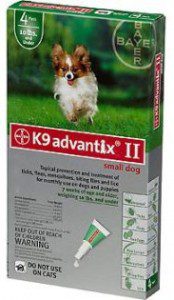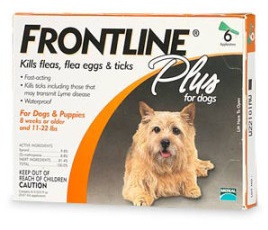By Ana Jadanec
Guest Writer for Wake Up World
While flea and tick products containing pesticides repel and kill parasites that can potentially transmit disease-causing organisms, they can be harmful to your pet, your child and even adults in your household. It is not without reason that they shouldn’t be used on debilitated, aged, pregnant or nursing animals. Their potential toxicity and a range of harmful effects is obvious, as these products must be applied in the only place the dog is unable to lick or bite – it’s back.
According to Bayer, their products are waterproof and remains effective following a shampoo treatment, swimming or after exposure to rain or sunlight. So just imagine what is transferred onto your hands, lips, or cheeks while you play with, pet or kiss your dog! Furthermore, what does it say about a product that, when left partly unused, you are advised to call your local solid waste agency for disposal instructions, and you are never to place unused product down any indoor or outdoor drain.
[pro_ad_display_adzone id=”110028″]
Nature is ever changing, ever evolving. Like cockroaches, fleas are highly adaptable to their environment. Each generation that is exposed to the pesticides and chemicals is learning how to adapt, become stronger and more immune to these toxins. By using these products, are we really only killing and repelling fleas, or are we creating the super pests of the future?
Some facts to consider:
A pesticide is generally a chemical or biological agent that through its effect deters, incapacitates, kills or otherwise discourages pests. According to the Stockholm Convention on Persistent Organic Pollutants, 9 of the 12 most dangerous and persistent organic chemicals are pesticides. (1) The Natural Resources Defense Council (NRDC) says that approximately 90 percent of American households use pesticides. Half of the surveyed families reported using insecticides to control fleas and ticks on pets. In the U.S. alone, more than a billion dollars a year are spent on flea and tick products. The pesticides in these products are often hazardous to the human brain and nervous system, containing chemicals that may disrupt the human hormone (endocrine) system, and are suspected of causing cancer. (2)
The US Environmental Protection Agency (EPA) says that number of reported incidents connected with all spot-on tick and flea products jumped from about 28,000 in 2007 to 44,000 in 2008, with 600 reported deaths. In addition, the EPA received more than 25,000 reports of adverse reactions to these products. (1) The products now on the market include seven specific “organophosphate insecticides” (OPs). In overdoses, OPs can also kill people and pets. But even with normal use of flea-control products containing OPs, pets and children may be in danger. EPA now calculates that a child’s exposure to individual OPs in pet products on the day of treatment alone can exceed safe levels by up to 500 times — 50,000 percent. The seven OPs are chlorpyrifos, dichlorvos, phosmet, naled, tetrachlorvinphos, diazinon and malathion. They are the active ingredients in dozens of pet products. You can find a more comprehensive list here.
Most people think that the pyrethrins (naturally occurring compounds from the chrysanthemum plant) and pyrethroids (the synthetic counterpart), are less hazardous than other tick and flea preventive ingredients. In fact, the contrary has been irrefutably proven. (4) Pyrethroid spot-ons flea and tick treatments account “for more than half of ‘major’ pesticide pet reactions reported to the EPA over the last five years. There are incidents involving serious medical reactions such as brain damage, heart attacks, and violent seizures. (3) It has been implicated as a carcinogenic insecticide causing lung cancer and liver tumors in laboratory animals. There is also a suspicion that it disrupts endocrine function. It can act as a neurotoxin, causing tremors and also increased aggressive behavior and learning problems. (4)
Let me give you an example of two very popular flea and tick products for dogs, K9 Advantix ® II and FRONTLINE ® Plus for Dogs sold in North America, Europe and Australia (probably in other parts of the world as well):
K9 Advantix ® II
It contains the active ingredient imidacloprid, which in lab studies has been found to increase cholesterol levels in dogs, cause thyroid lesions and liver toxicity and has the potential for damaging the liver, kidney, thyroid, heart, lungs, spleen, adrenal, brain, and gonads. As a neurotoxin, it has caused in-coordination, labored breathing and muscle weakness.
 According to K9 Advantix II’s product label, these are the potential:
According to K9 Advantix II’s product label, these are the potential:
HAZARDS TO HUMANS – Causes substantial but temporary eye injury. Do not get in eyes or on clothing. Harmful if swallowed. Avoid contact with skin or clothing. Wash thoroughly with soap and water after handling and before eating, drinking, chewing gum, or using tobacco. Remove and wash contaminated clothing before reuse.
HAZARDS TO DOMESTIC ANIMALS – For external use on dogs only. Do not use on animals other than dogs. Do not use on puppies under seven weeks of age. Do not get this product in dog’s eyes or mouth. As with any product, consult your veterinarian before using this product on debilitated, aged, pregnant or nursing animals. Individual sensitivities, while rare, may occur after using ANY pesticide product for pets. If signs persist, or become more severe, consult a veterinarian immediately. If your animal is on medication, consult your veterinarian before using this or any other product.(6)
FRONTLINE ® Plus for Dogs
It combines the active ingredient with (S)-methoprene, an insect growth regulator. Fipronil works by attacking the nerve cells of fleas, resulting in their becoming disorientated and hyperactive before dying. (S)-methoprene interferes with egg production and hatching of fleas, as well as inhibiting larval development.
 A study by the (SENSOR)-Pesticides Program and the California Department of Pesticide Regulation (7) found that over the last decade, fipronil’s residues can now be found in 40% of American homes. Reported symptoms include conjunctivitis, headache, dizziness, nausea, vomiting, abdominal pain, oropharyngeal pain, cough, sweating, sensory impairment, weakness, drowsiness, agitation, and seizure.
A study by the (SENSOR)-Pesticides Program and the California Department of Pesticide Regulation (7) found that over the last decade, fipronil’s residues can now be found in 40% of American homes. Reported symptoms include conjunctivitis, headache, dizziness, nausea, vomiting, abdominal pain, oropharyngeal pain, cough, sweating, sensory impairment, weakness, drowsiness, agitation, and seizure.
The study also found that pet-care products containing fipronil were related to more than one-third of cases and accounted for the majority of childhood cases (64%). Pet owners who use fipronil (Frontine ®) should remember that these petcare products are pesticides with inherent toxicity. An experimental study showed that for up to four weeks after spot-on treatment of dogs with Frontline ®, fipronil residues were detected on gloves worn while petting the dogs for 5 minutes. The effect of Frontline ® is reported to last for a month and monthly reapplications are usually recommended. Thus, repetitive and/or chronic exposure to low doses may occur if precautionary actions are not taken.
The NATURAL alternatives
To learn more about natural alternatives for the treatment of fleas and ticks on dogs and cats, please see Ana’s previous article: 30 Natural Ingredients and Easy Home Remedies to Repel Fleas and Ticks on Dogs (and Some for Cats Too!)
References:
(1) http://en.wikipedia.org/wiki/Pesticide
(2) Natural Resources Defence Council: Poisons on Pets
http://www.nrdc.org/health/effects/pets/execsum.asp
(3) EPA Data Evaluation Records of 2008 Pet Spot-On Products
http://www.epa.gov/pesticides/health/petproductsders.html
(4) http://www.dogandcatvitamins.com/flea-and-tick-top-spots-exposed/
(5) http://animalwellnesspei.com/?p=22
(6) http://bayer.naccvp.com/?m=product_view_basic&id=1040070&u=bayer&p=dvm
(7) Texas Department of Health Services
Previous articles by Ana:
- 30 Natural Ingredients and Easy Home Remedies to Repel Fleas and Ticks on Dogs
- Happy Armpits: Make Your Own Coconut Oil Deodorant (Recipe Included!)
- 9 FAQs About “Happy Armpits: Make Your Own Coconut Oil Deodorant
About the author:
Croatian-born Ana is a quirky star-child who strives to expand into different activities and touch as many aspects of life as she can. She is not here to preach nor teach, just to share a different perspective of life on Earth and the various potentials she has found within. Ana lives life intuitively and freely, and hopes that her love for the starry sky, our space brothers and sisters, planet Earth, nature, dogs, sewing and life will enable her to shine tiny sparkles of hope and love around the world.
Visit Ana’s website: https://analilscorner.wordpress.com
This article edited by Andy Whiteley for Wake Up World.
[pro_ad_display_adzone id=”110027″]







